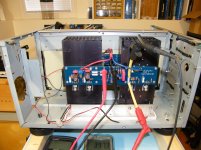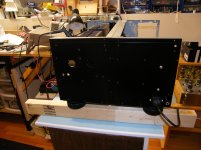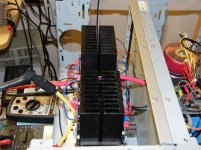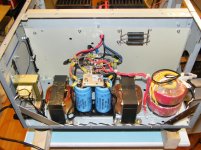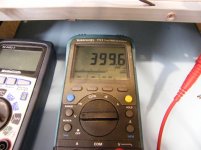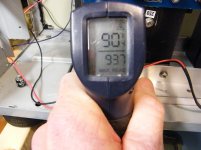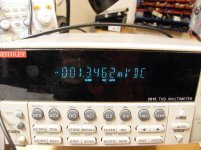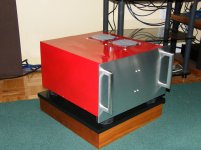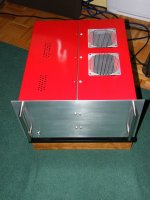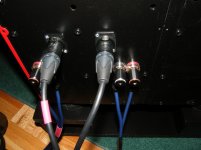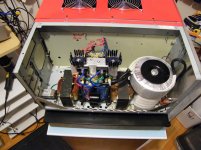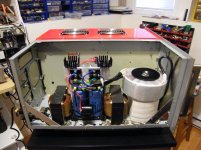Hi folks
Been gathering parts for a J for a while. I have used a lot of recycled parts in the chassis and power supply and the whole project is a bit of an experiment so please take it in that spirit. I bought boards from the store and matched my own power FETS on a test rig I made that matches them at roughly operating temperature and at 1 amp current. Got the Jfets from Jims Audio and they tested with the correct transconductance and were well matched at 10.7ma. This is a bit higher than spec so I would like advice on if I should adjust the stock 12ma LTP current.
The chassis, heatsinks and transformers are all surplus. The power supply is LC filtered-10mh 12.5amp .11ohm inductors and about 70kuf per side.
As the pictures show it's an odd looking beast being almost a foot high with the feet on it. The chassis is from 2 large surplus computer UPS units that I welded together to give the space for the large supply and the amp section with fans under the vertical heatsinks. The heatsinks are live, all 4 being isolated from each other by 1/4" phenolic and the 240s are mounted directly to the sinks using Wakefield 126 compound.
I have run 1 channel up on a variac and with 22vdc supplies I was easily able to set the bias to .4v and the offset to <1mv. After 45 minutes the bias had hardly moved and offset was <1.5mv. It seemed to drift up and down a bit with line voltage changes. The hottest temp I could find on the 240s or heatsinks with an IR thermometer was 93f or 34c with an ambient of 20c for a 14c rise in temp with .4v bias and 22v supplies. I am surprised by how cool they ran but the fans are quite noisy running at near their full rated voltage of 24v. I plan to add a speed control for the fans and also to look at quieter models. I don't think I can go much further than .4volt with my current transformers which are under sized at 125w each.
Next step will be to bring up the other channel, adjust it and then finish the input, output connectors and the chassis front panel etc. Can't wait to hear it! I've been doing this for close to 40 years and it's still as fun as ever! Heres a few pictures. The meter readings were taken after being on for about 45minutes and about 30 minutes after the last adjustment. I also adjusted the LTP current to 12ma.
Been gathering parts for a J for a while. I have used a lot of recycled parts in the chassis and power supply and the whole project is a bit of an experiment so please take it in that spirit. I bought boards from the store and matched my own power FETS on a test rig I made that matches them at roughly operating temperature and at 1 amp current. Got the Jfets from Jims Audio and they tested with the correct transconductance and were well matched at 10.7ma. This is a bit higher than spec so I would like advice on if I should adjust the stock 12ma LTP current.
The chassis, heatsinks and transformers are all surplus. The power supply is LC filtered-10mh 12.5amp .11ohm inductors and about 70kuf per side.
As the pictures show it's an odd looking beast being almost a foot high with the feet on it. The chassis is from 2 large surplus computer UPS units that I welded together to give the space for the large supply and the amp section with fans under the vertical heatsinks. The heatsinks are live, all 4 being isolated from each other by 1/4" phenolic and the 240s are mounted directly to the sinks using Wakefield 126 compound.
I have run 1 channel up on a variac and with 22vdc supplies I was easily able to set the bias to .4v and the offset to <1mv. After 45 minutes the bias had hardly moved and offset was <1.5mv. It seemed to drift up and down a bit with line voltage changes. The hottest temp I could find on the 240s or heatsinks with an IR thermometer was 93f or 34c with an ambient of 20c for a 14c rise in temp with .4v bias and 22v supplies. I am surprised by how cool they ran but the fans are quite noisy running at near their full rated voltage of 24v. I plan to add a speed control for the fans and also to look at quieter models. I don't think I can go much further than .4volt with my current transformers which are under sized at 125w each.
Next step will be to bring up the other channel, adjust it and then finish the input, output connectors and the chassis front panel etc. Can't wait to hear it! I've been doing this for close to 40 years and it's still as fun as ever! Heres a few pictures. The meter readings were taken after being on for about 45minutes and about 30 minutes after the last adjustment. I also adjusted the LTP current to 12ma.
Attachments
way to go Brian  .
.
p.s. I have assembled Aleph30 boards collecting dust. I listened to them for about a year but never tried converting to AJ as I felt I could not trade off any power, (A30 was running on 25.5V rails and 0.7amp per fet bias). vocals were superb. wish you were closer so we could slap them on and compare them back to back. recently Generg kind of resurrected the old flare by trying all the iterations, with Toshiba inputs as well.
p.s2 btw your matched fets are singing nicely in my BA3bs with F4s in the OS. Thanks again!
p.s. I have assembled Aleph30 boards collecting dust. I listened to them for about a year but never tried converting to AJ as I felt I could not trade off any power, (A30 was running on 25.5V rails and 0.7amp per fet bias). vocals were superb. wish you were closer so we could slap them on and compare them back to back. recently Generg kind of resurrected the old flare by trying all the iterations, with Toshiba inputs as well.
p.s2 btw your matched fets are singing nicely in my BA3bs with F4s in the OS. Thanks again!
way to go Brian.
p.s. I have assembled Aleph30 boards collecting dust. I listened to them for about a year but never tried converting to AJ as I felt I could not trade off any power, (A30 was running on 25.5V rails and 0.7amp per fet bias). vocals were superb. wish you were closer so we could slap them on and compare them back to back. recently Generg kind of resurrected the old flare by trying all the iterations, with Toshiba inputs as well.
p.s2 btw your matched fets are singing nicely in my BA3bs with F4s in the OS. Thanks again!
Hi Sonny, it's good to hear from you. I haven't had any complaints on the FETs I matched by the high current pulse method but it's good to hear yours are working well. I have loads of matched power FETs around so I thought I would get busy on the J even though I haven't finished the Aleph P yet. I now have a DAC with a set of volume controlled balanced outs, so that will be acting as a preamp for a while
I'm going to be using the amp with a set of PI 3s with upgraded drivers and crossovers. They are at least 95db efficiency and 8 ohms so it should be a nice match.
Got the second channel up and adjusted. It was a bit trickier physically because of it being the inside channel. I had holes in the chassis for an alignment tool to adjust each pot but the wiring and the rectifiers on the power supply side of the chassis got in the way of the offset adjust in particular.
I need to move the rectifiers or add more heatsinking. The peak temperature near them on the heatsink was 130f which is too hot. The heat is going into the filter caps. I thought the piece of 1/4" aluminum would be enough. Since my supply voltage is a bit low at 21.6v with 115v in I may try Schottky diodes to pick up a bit of voltage.
I had a look at the amp power consumption using a plug in line monitor. With .4v bias it was drawing 186watts, 206 volt amps. The high power factor is likely due to the choke input supply. The chokes feel cold and the transformers are warm but less than 100f. Looks like a little more bias would be possible but I will probably stick to the stock settings to try it out. I should be able to reduce the fan speed a bit and still run at a reasonable temperature.
Next I will fix the hot rectifier issue and then install the back panel connectors and in/out wiring.
you can make zillion watt Aleph J

I anxiously await your Fugly rating when the amp is done. I was unsure how hot it would run with those heatsinks. They are about 100mm w and 210h with 25mm fins and a 8mm base thickness. Fan cooling and direct mounting to the sink really seem to have cooled things down nicely. I'm not sure of the cfm of those fans. That's on my list of stuff to do. They are the quietist ones I had on hand.
finish it and put cover on ........ and you'll get two Fugly!s , for real proper engineering approach

tip: 12cm dia fans from dead/Dodo/drek PC power supplies , when cleaned and lubed (20W40) , fed with 7V are dead silent ......... and usually even modest size heatsinks are big enough , for combining
tip: 12cm dia fans from dead/Dodo/drek PC power supplies , when cleaned and lubed (20W40) , fed with 7V are dead silent ......... and usually even modest size heatsinks are big enough , for combining
Last edited:
you can make zillion watt Aleph J

well I guess the choice would be an AlephJX or your scalable Babelfish?
Not that I did not get that you were probably pulling my leg here
@Brian
I so far always did fans. Noctua fans are so damn quiet you would not believe it.
http://www.diyaudio.com/forums/pass-labs/201281-burning-amp-ba-3b-balanced-57.html#post4794952
If you really get into it, I have a spare control board a friend helped me develop. it controls fan speed on temp feedback, does soft start and manages speaker connect/disconnect (for turn on/off thumps); even has speaker protection function (but i never bothered with the latter; so that would probably need fine-tuning). if you get to a point where you need it I can flash a controller with the software (give you the code too) and a board.
naah ...........
just make enough of plain old Aleph 30 , then bridge them then bridge them then bridge them then bridge them then bridge them then bridge them then bridge them then bridge them then bridge them then bridge them then bridge them then bridge them then bridge them then bridge them then bridge them then bridge them then bridge them then bridge them then bridge them then bridge them then bridge them then bridge them then bridge them then bridge them then bridge them then bridge them then bridge them then bridge them then bridge them then bridge them then bridge them then bridge them then bridge them then bridge them then bridge them then bridge them then bridge them then bridge them then bridge them then bridge them then bridge them then bridge them then bridge them then bridge them then bridge them then bridge them until you get zillion watts

just make enough of plain old Aleph 30 , then bridge them then bridge them then bridge them then bridge them then bridge them then bridge them then bridge them then bridge them then bridge them then bridge them then bridge them then bridge them then bridge them then bridge them then bridge them then bridge them then bridge them then bridge them then bridge them then bridge them then bridge them then bridge them then bridge them then bridge them then bridge them then bridge them then bridge them then bridge them then bridge them then bridge them then bridge them then bridge them then bridge them then bridge them then bridge them then bridge them then bridge them then bridge them then bridge them then bridge them then bridge them then bridge them then bridge them then bridge them then bridge them then bridge them until you get zillion watts

well I guess the choice would be an AlephJX or your scalable Babelfish?
Not that I did not get that you were probably pulling my leg here.
@Brian
I so far always did fans. Noctua fans are so damn quiet you would not believe it.
http://www.diyaudio.com/forums/pass-labs/201281-burning-amp-ba-3b-balanced-57.html#post4794952
If you really get into it, I have a spare control board a friend helped me develop. it controls fan speed on temp feedback, does soft start and manages speaker connect/disconnect (for turn on/off thumps); even has speaker protection function (but i never bothered with the latter; so that would probably need fine-tuning). if you get to a point where you need it I can flash a controller with the software (give you the code too) and a board.
Thanks for the offer Sonny. I'm hoping to keep it simple but that board sounds like it would make a great project for anyone DIYing an amp.
Amp update:
Got the amp running stable on both channels. Moved it into the listening room and gave it a listen. Noise seems very low, certainly lower than the fans, which I have turned down to 16 volts with only a small increase in temperature. I will be ordering quieter fans soon.
Sound wise it's too soon to make any judgments. The bass certainly seemed powerful but nothing else really stood out. That fan noise has got to be much lower for my quiet listening room.
I'll try to do some measurements and fine tuning of bias etc. later in the week.
Time for an update. It's a busy time of year here what with getting the property ready for winter. I've been doing a lot of listening to the Aleph J lately. It certainly sounds different than my daily driver amp a W4S STI500 which is from the complete opposite end of the equipment spectrum with 250w of class d power, although it does use a jfet preamp section.
If I had only one word to describe the sound of the aleph J it would be resolution. This is especially apparent to me when listening to someone like Shirley Horn who made a very successful, at least in my opinion, comeback in the late 80s, producing some great recordings during the next 15 years. The great resolution of the J brings more detail and somehow integrates the detail into the music in a way that allows the emotional content to shine through. I have not done any direct A/B comparisons but I find myself being drawn into great performances much more when listening through the J. My initial impression is that dynamics are slightly less but perhaps more realistic, who knows. Power is adequate for quite loud levels driving 95db/w 8 ohm speakers. Electrical noise is pretty much nil, even with your ear parked up close to the drivers. However, with an LC power supply the chokes are doing some heavy lifting and they buzz noticeably. As soon as the cover is put on the power supply side of the chassis the entire chassis starts to hum at an unacceptable level. Since I am currently using undersized transformers I have ordered a 400w transformer with the intent to convert the supply to CLC. Experiments indicate that the chokes are quiet when driving this type of filter and with 400w available the extra dissipation from the capacitive input supply will not be a problem. With the LC supply the ripple voltage is typically 25-30mv rms on the +-24v rails. Perhaps this helps to keep hum out of the output.
Here are a few pictures of the chassis. The 2 half covers will be bolted down with an aluminum strip over them to hide the joint running down the centre of the top. I also have some quieter fans on order and may switch out those aluminum fan covers to something more conventional. The front panel is 1/8" aluminium and the handles were from Lee Valley. Neutrik XLRs and EBay rhodium plated speaker connectors on the back.
If I had only one word to describe the sound of the aleph J it would be resolution. This is especially apparent to me when listening to someone like Shirley Horn who made a very successful, at least in my opinion, comeback in the late 80s, producing some great recordings during the next 15 years. The great resolution of the J brings more detail and somehow integrates the detail into the music in a way that allows the emotional content to shine through. I have not done any direct A/B comparisons but I find myself being drawn into great performances much more when listening through the J. My initial impression is that dynamics are slightly less but perhaps more realistic, who knows. Power is adequate for quite loud levels driving 95db/w 8 ohm speakers. Electrical noise is pretty much nil, even with your ear parked up close to the drivers. However, with an LC power supply the chokes are doing some heavy lifting and they buzz noticeably. As soon as the cover is put on the power supply side of the chassis the entire chassis starts to hum at an unacceptable level. Since I am currently using undersized transformers I have ordered a 400w transformer with the intent to convert the supply to CLC. Experiments indicate that the chokes are quiet when driving this type of filter and with 400w available the extra dissipation from the capacitive input supply will not be a problem. With the LC supply the ripple voltage is typically 25-30mv rms on the +-24v rails. Perhaps this helps to keep hum out of the output.
Here are a few pictures of the chassis. The 2 half covers will be bolted down with an aluminum strip over them to hide the joint running down the centre of the top. I also have some quieter fans on order and may switch out those aluminum fan covers to something more conventional. The front panel is 1/8" aluminium and the handles were from Lee Valley. Neutrik XLRs and EBay rhodium plated speaker connectors on the back.
Attachments
Got the new transformer installed. It's an Antek 400w with 2x 20v windings. With 115volts going into the primary I am getting +-23volts loaded with a bias setting of .44v or .94amps/fet. It is dead quiet and the 400w size has a static shield and is designed for use in audio power amps.
I had ordered what I thought were quiet fans rated at 22db. Even with them turned down to 12volts from 24 they were still too loud. I took advice from member Koja and ordered 2 Noctua NF-8a ULN fans. They were a bit more expensive but are packaged with adapters, cable extenders and a voltage reducing cable that lowers the voltage from the rated 12v to 10. They are rated at 10.4db in the 10v ULN mode. I have the amp playing now and I can still just barely hear it in my very quiet room, but it is not as loud as the drive in my mac mini. The noise is also low in frequency and easy to ignore. Well worth the extra money. The fans also come with vibration isolating mounts as an option. Also guaranteed for 6 years with a 150K hour MTBF. I'm impressed with these. Highly recommended to anyone going the fan cooled route.
I have been having trouble with low AC line voltage. It was sometimes sagging to 100volts. I called the utility and they seemed concerned and said they would investigate when time permitted. Anyway a few days ago we had a power outage for no apparent reason. It was out for 3 hours and when it came back on the AC was at more normal levels. It has been 115-116 all day today. So I now should be able to get all 25 watts out of the J. With the higher than stock bias and 23-24 volts DC and almost no ripple I may even get all the way to 30w!
I also changed to larger bridges and mounted them on a large heatsink to keep the temps down. With the new fans installed and running them at 10volts dc I am getting main heatsink temperatures around 43-45c which is a nice safe figure. Having vertical heatsinks gives you some advantage because of natural convection helping to move air up through the heat sinks. I also have the FETS directly mounted to the sinks with thermal grease only. This seems to help a lot in keeping the temps of the FETS down. They don't feel any hotter than the surrounding heatsink. Of course this requires you to have four electrically isolated heatsinks. I have left lots of room under the amp by making a stand that has a cutout under the fans, leaving lots of area for air to move unrestricted into the bottom of the amp.
Heres a few pictures of the transformer /rectifier install.
I had ordered what I thought were quiet fans rated at 22db. Even with them turned down to 12volts from 24 they were still too loud. I took advice from member Koja and ordered 2 Noctua NF-8a ULN fans. They were a bit more expensive but are packaged with adapters, cable extenders and a voltage reducing cable that lowers the voltage from the rated 12v to 10. They are rated at 10.4db in the 10v ULN mode. I have the amp playing now and I can still just barely hear it in my very quiet room, but it is not as loud as the drive in my mac mini. The noise is also low in frequency and easy to ignore. Well worth the extra money. The fans also come with vibration isolating mounts as an option. Also guaranteed for 6 years with a 150K hour MTBF. I'm impressed with these. Highly recommended to anyone going the fan cooled route.
I have been having trouble with low AC line voltage. It was sometimes sagging to 100volts. I called the utility and they seemed concerned and said they would investigate when time permitted. Anyway a few days ago we had a power outage for no apparent reason. It was out for 3 hours and when it came back on the AC was at more normal levels. It has been 115-116 all day today. So I now should be able to get all 25 watts out of the J. With the higher than stock bias and 23-24 volts DC and almost no ripple I may even get all the way to 30w!
I also changed to larger bridges and mounted them on a large heatsink to keep the temps down. With the new fans installed and running them at 10volts dc I am getting main heatsink temperatures around 43-45c which is a nice safe figure. Having vertical heatsinks gives you some advantage because of natural convection helping to move air up through the heat sinks. I also have the FETS directly mounted to the sinks with thermal grease only. This seems to help a lot in keeping the temps of the FETS down. They don't feel any hotter than the surrounding heatsink. Of course this requires you to have four electrically isolated heatsinks. I have left lots of room under the amp by making a stand that has a cutout under the fans, leaving lots of area for air to move unrestricted into the bottom of the amp.
Heres a few pictures of the transformer /rectifier install.
Attachments
- Status
- This old topic is closed. If you want to reopen this topic, contact a moderator using the "Report Post" button.
- Home
- Amplifiers
- Pass Labs
- Another Aleph J, fan cooled, LC filtered supply
